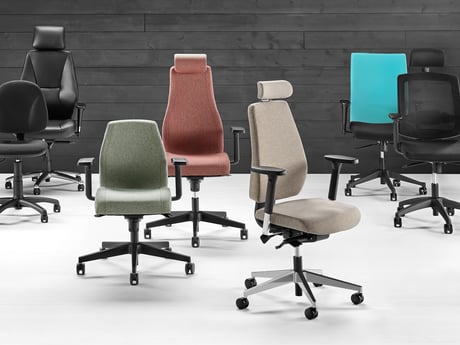How office design can improve employee mental health and wellbeing

Employee health and wellbeing can have a significant impact on your company’s bottom line. Soma Analytics’ Mental Health and Wellbeing: FTSE 100 Report 2018 showed that FTSE 100 companies that placed an emphasis on employee wellbeing and mental health significantly outperformed those that considered it less important. The 54 companies that mentioned "mental health" or "wellbeing" more than three times in their annual report posted median profits 130% higher than the 46 companies that mentioned it three times or fewer.
Find out how to create a calming office environment so you can ensure that your workplace does everything it can to support employee mental wellbeing.
Colours
The colours you choose for your office can have a surprising effect on employee wellbeing, affecting everything from mood to efficiency. Blue tones create a sense of security and harmony. This popular colour increases productivity while also promoting communication. Likewise, green, thanks to its associations with nature, is calming and can ease decision making. Green is also linked to higher levels of creativity. At the other end of the spectrum, red can make it harder to concentrate, reduce analytical thinking and increase stress.
Acoustics
High noise levels are one of the biggest complaints that employees have about their workplace. Noisy workplaces have been shown to increase stress and reduce concentration levels. Acoustic solutions such as desk screens, acoustic wall panels and ceiling hanging panels are designed to reduce overall noise levels by absorbing reverberations. Studies have shown that making specific adjustments to the acoustic conditions in open office environments with the goal of removing "conversational distractions" reduces stress by 27% (when measured in terms of the physical symptoms of stress).
Sit-stand office furniture
Not only does active office furniture improve physical health, it also has a knock-on effect on mood and productivity. A study of 146 NHS staff led by researchers from the Universities of Leicester and Loughborough and published in the British Medical Journal (BMJ) demonstrated that sit-stand desks have a positive effect on mental wellbeing at work. At the end of the one-year study, participants who had been given a standing desk reported improved quality of life, reduced fatigue and reduced anxiety as well as better engagement with their work.
Flexibility
According to Steelcase, 40% of workers say they don’t have enough informal spaces in their workplace. By offering diverse work environments in the office, you support different personality types as well as different roles in the company, allowing employees to choose their work environment based on their current task. An ideal activity-based workplace will a mixture of quiet private spaces, collaborative working areas and social spaces. This innovative approach has been shown to increase creativity, productivity and happiness in the workplace.
Don’t stop with the office, small changes to company policy can have a big impact on employee psychological wellbeing and can save your company a lot of money by reducing sick leave and increasing productivity. This could be offering flexible hours, setting up a wellness programme, or even something as simple as encouraging staff to take a proper lunch break.



